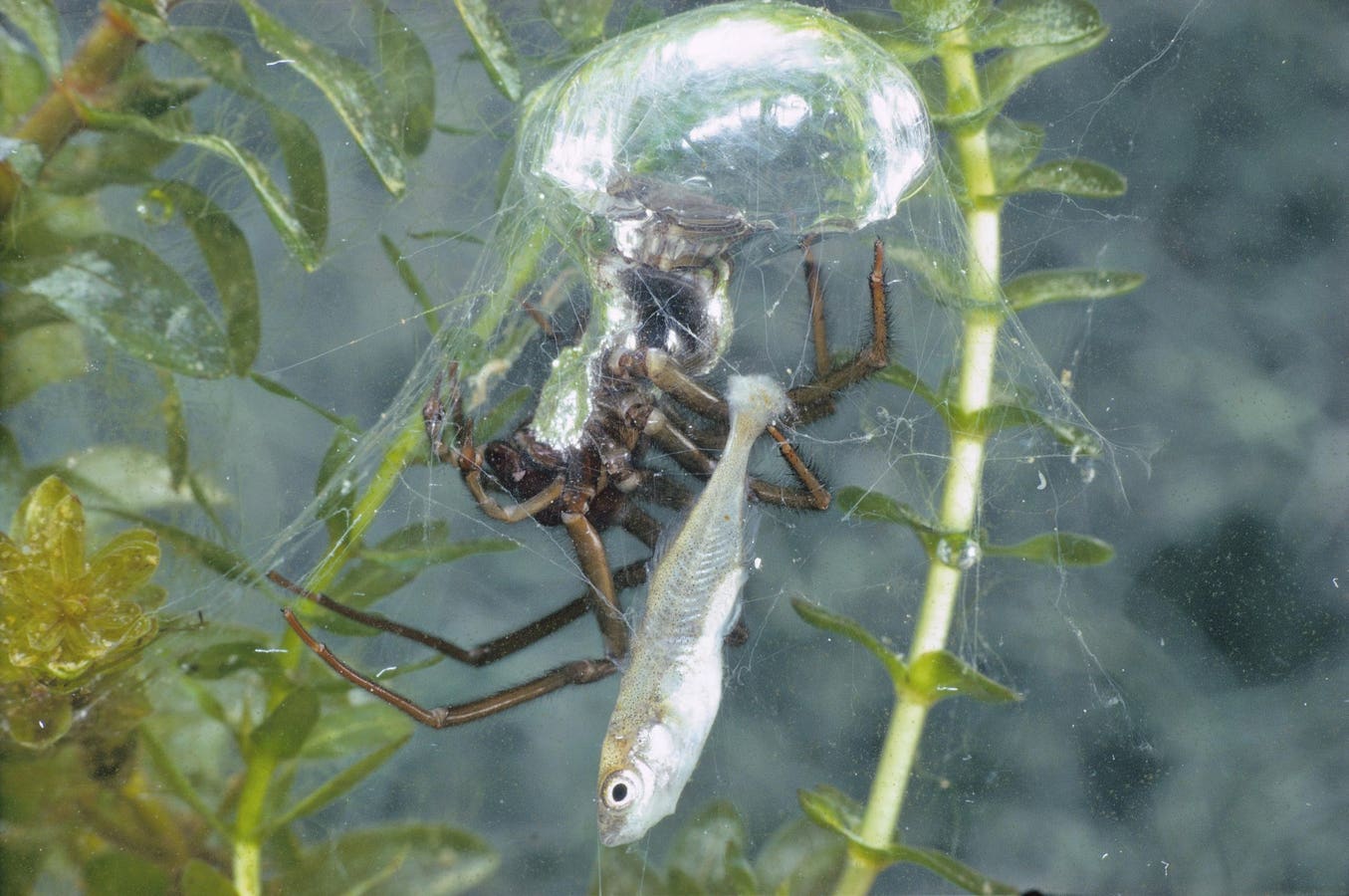The diving bell spider spends nearly its entire life submerged eating, mating and even sleeping … More
Quick, think of every place you’ve seen a spider. A forest floor, an old attic, dangling from a tree branch? I’ll bet “while swimming” didn’t even cross your mind. Unless, that is, you’ve run into one very strange exception.
Found in calm ponds and marshy streams across Europe and parts of Asia, this exception — the water spider or diving bell spider — is barely half an inch long. And it doesn’t spin webs in the dark corners of your house. Instead, it builds them underwater, anchoring silk to plants just below the surface. Then it fills that web with air and slips into a fully aquatic lifestyle — eating, sleeping and even raising its young inside a homemade diving bell.
Here are two reasons why the diving bell spider can pull this off, while almost every other spider sticks to dry land.
1. Its Homemade ‘Diving Bell’
There are semiaquatic spiders out there. These are the species that can skate across the surface of water, dive briefly to escape predators or hide in moist environments. But none of them live entirely underwater. The diving bell spider is the only one that does. And it pulls this off thanks to the bizarre structure that gives it its name: a silk air chamber spun below the surface.
This diving bell is a full-on life support system. The spider anchors a web between submerged vegetation and then makes multiple trips to the surface, collecting tiny air bubbles. It releases that air into the bell, gradually inflating it like a balloon held underwater.
These diving bells serve as the spider’s safe haven. For many, it’s where life begins. The mother … More
But here’s the most impressive part. The structure works a bit like a temporary, external gill. Oxygen from the surrounding water diffuses into the bell while carbon dioxide escapes out, allowing the spider to stay submerged for hours without surfacing.
2. Its Water-Repellent Hairs That ‘Trap’ Air
Remember how these spiders make multiple trips to the surface to collect air for their diving bell? That only works because their bodies are covered in microscopic, water-repellent hairs. These hairs — called hydrofuge setae — trap a thin film of air around the spider every time it surfaces. That trapped layer gives the spider its silvery shimmer underwater, like it’s been dipped in mercury.
Every trip to the surface is a refill run. The spider loads up on air, dives down and injects a little bit of Earth’s atmosphere into its diving bell. The hairs hold the bubble in place just long enough for the transfer. Lose the bubble too soon, and the effort’s wasted. Hold it too long, and the system becomes inefficient.
That air layer also reduces drag, letting the spider glide more easily through water. Some researchers even think it acts as a microbial shield — a barrier between the spider and any bacteria in the pond.
The spider’s silk may get the attention, but without this invisible wetsuit, the whole operation falls apart.
A Little More About The Diving Bell Spider’s Life Underwater
The diving bell spider spends almost its entire life submerged, surfacing only to collect air. Hunting, mating, molting and laying eggs — all of it happens inside (or near) its diving bell. Its prey includes aquatic insects, tiny crustaceans and the occasional small fish (see cover image) or tadpole.
It hunts from inside the bell or nearby, darting out when movement triggers the web’s silk threads, much like a traditional web spider responds to vibrations. The males are larger (unusual in the spider world, where females are generally larger than males) and more active, often moving between bells to seek out mates. Females, meanwhile, are more stationary and build larger bells, as these double as nurseries.
After mating, the female lays her eggs inside the bell and seals them off in a protective cocoon. The young hatch and remain inside for a while before dispersing into the water to build tiny bells of their own.
Most diving bell spiders live for about one to two years. In that time, they rarely touch dry land. Above water, they’re just another small arachnid. But underwater — silk-spinning, air-trapping and bubble-dwelling — they’re in a category of their own.
If spiders already creep you out, the idea of bumping into one underwater, in its own oxygen-filled lair, probably doesn’t help. Take the Fear of Animals Scale and see where you stand.








